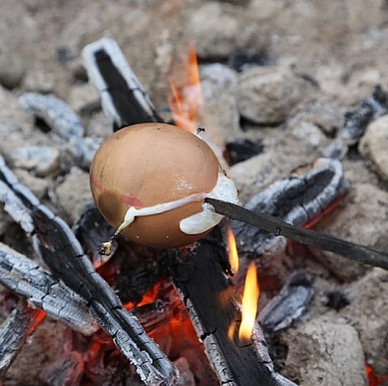The west coast of Davao Gulf between Daliao and Digos is dotted with small villages, the inhabitants of which are largely Bagobo who have been converted to the Christian faith and have been induced to give up their mountain homes and settle in towns. Back of this coast line rise densely timbered mountain peaks, lateral spurs from which often terminate in abrupt cliffs overlooking the sea. From other peaks extensive grass covered plains slope gently down nearly to the water’s edge. Deep river canons cut between these mountains and across the plains, giving evidence of active erosion for a long period of time. If these mountain chains and river courses are followed back it is found that they all radiate from one stupendous mass, the center of which is Mt. Apo, the highest mountain in the Philippines and reputed to be an active volcano. Near to its summit is a deep fissure from which, on clear mornings, columns of smoke or steam can be seen ascending, while the first rays of the rising sun turn into gold, or sheets of white, the fields of sulphur which surround the cone.
Along the lower eastern and southern slopes of this mountain and its tributary peaks live the wilder branch of this tribe, whose traditions, religious observances, and daily life are closely related to the manifestations of latent energy in the old volcano.
There are not, as a rule, many thefts among the Bagobo, for they believe that a thief can be discovered easily by means of their famous ‘bongat’. That consists of two small joints of bamboo, which contain certain mysterious powders. He who has been robbed and wishes to determine the robber takes a hen’s egg, makes a hole in it, puts a pinch of the above said powder in it, and leaves it in the fire. If he wishes the robber to die he has nothing else to do than to break the egg; but since the thief may sometimes be a relative or a beloved person, the egg is not usually broken, so that there may be or may be able to be a remedy. For under all circumstances, when this operation is performed, if the robber lives, wherever he may be, he himself must inform on himself by crying out, ‘I am the thief; I am the thief,’ as he is compelled to do (they say) by the sharp pain which he feels all through his body. When he is discovered, he may be cured by putting powder from the other joint into the water and bathing his body with it. This practice is very common here among the pagans and Moros.

SOURCE: THE WILD TRIBES
OF DAVAO DISTRICT,
MINDANAO
FAY-COOPER COLE
September, 1913
ALSO READ: BAGOBO AREA | Beliefs Concerning the Soul, Oracles & Magic
Jordan Clark is a Canadian born descendant of Scottish immigrants living on the homelands of the Lekwungen speaking peoples. His interest in Philippine myth and folklore began in 2004. Finding it difficult to track down resources on the topic, he founded The Aswang Project in 2006. Shortly after, he embarked on a 5 year journey, along with producing partner Cheryl Anne del Rosario, to make the 2011 feature length documentary THE ASWANG PHENOMENON – an exploration of the aswang myth and its effects on Philippine society. In 2015 he directed “The Creatures of Philippine Mythology” web-series, which features 3 folkloric beings from the Philippines – the TIKBALANG, KAPRE and BAKUNAWA. Episodes are available to watch on YouTube. Jordan recently oversaw the editing for the English language release of Ferdinand Blumentritt’s DICCIONARIO MITOLÓGICO DE FILIPINAS (Dictionary of Philippine Mythology) and is working on two more releases with fellow creators scheduled for release later this year. When his nose isn’t in a book, he spends time with his amazing Filipina wife of 20 years and their smart and wonderful teenaged daughter.


